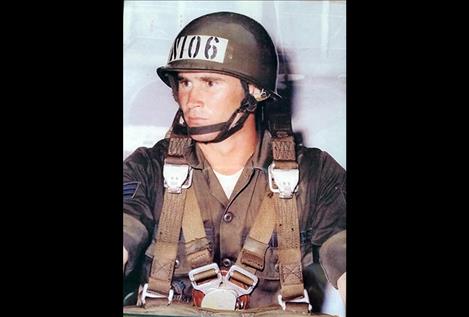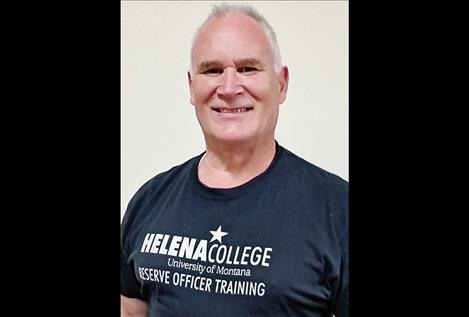Veteran Spotlight
James L. Pettit, August 8, 1961 Cold War + Operations in the Persian Gulf U.S. Air Force, Retired
Hey savvy news reader! Thanks for choosing local.
You are now reading
3 of 3 free articles.
There are a lot of different reasons for joining the military. When in high school, Jim Pettit took the opportunity through the 1973 CETA program (Comprehensive Employment and Training Act) to work with the Ronan, Montana Police Department. Things weren’t good at home, and deciding he liked law enforcement type work, he tried to join the Navy. He was only 16 and he was caught at Butte, Montana. The Navy sent him home and that made him mad, so, forget the Navy! When he was 17, his mom signed for him and he decided to join the Air Force.
Jim went to Lackland Air Force Base, San Antonio, Texas, “Gateway to the Air Force,” on Jan. 23, 1979 for eight weeks of basic training. At that time the Air Force was trying to evolve and transition to include more women so there were efforts to promote individual acceptance. Training included the usual marching, gun experience, and chemical warfare training, but also encouragement to make decisions without always waiting to be told what to do. This was not so in the other branches of the military. Jim became an “expert marksman,” was a “distinguished honor graduate” and was promoted to E3.
The next step was 10 weeks of Technical Training School at Chanute Air Force Base, Champaign/Urbana, Illinois. Jim’s area was fire protection and rescue related to structural fires and any aerospace vehicles. He studied fire science and theory, and engineering for all firefighting equipment. Chanute was the best school in the world for this training and all branches of the military sent men there.
Jim’s first duty station was San Vito dei Normanni Air Station in Italy. He was actually assigned to state-side but “swapped” with a guy who didn’t want to go overseas. This was ok with the Air Force which just needed a body at each assignment. Jim flew to Rome and then bused to Naples and on to San Vito. He remembers Rome as being crowded with impressive old architecture. Italy became more primitive the farther south he went. San Vito was a remote, rustic, dry and rocky agrarian area, 100 years behind the times. Farmers still used horses.
San Vito was an Air Station rather than a base because it didn’t have a flight line. The mission was electronic surveillance – a spy base over all Eur-Asia. It housed an ANP-FLR9 for listening to code. It was 11 stories high, a mile in circumference and was called the “elephant cage.” Jim’s job was support for the mission.
When President Reagan was elected in 1980, things started looking up for the military. Morale, which had been so low after the Vietnam War, improved, and it was once again a privilege to be in the military. The military received the equipment, training and people it needed. Jim says President Reagan was an outstanding Commander in Chief.
Jim was recruited as an augmentee for security with the EST (Emergency Service on Team) on terrorism. During the Iranian hostage situation the base’s mission was to relay information between the fleet and the rescue unit. The Arab Alliance claimed this was a violation of the contract with Italy and NATO so the station could be fired upon. They were surrounded by hostiles and finally U.S. Navy Seals were brought in from the fleet to rescue American dependents living in local areas. U.S. troops were advised to pull the magazines and ammunition from their weapons to avoid an international incident, and to account for each bullet. They did not. There were many terrorist organizations active at that time and Jim’s group worked with the CIA, Mi-6, Massad, and other international anti-terrorism agencies. During his 18 months in this field, he had one bad occurrence but since it was the Cold War, it was never reported and is still classified.
Jim was promoted to E4 and sent to Pope AFB, North Carolina for special operations. He worked with Air Traffic Control in Biloxi, Mississippi and went to Airborne jump school at Fort Benning, Georgia. He then went back to Pope AFB for combat control school. He served as an air traffic controller, assigned with other friendly forces – two-man teams, at times with foreign troops. He trained in small arms, demolition, survival skills, counter terrorism and ingress procedures such as scuba, rappelling from helicopters, etc.
Then the Air Force decided it needed his firefighter skills back in fire protection, so Jim was sent on a 12-month tour to Galena AFB, Alaska, the closest intercept point to Russia. They were shot at and scrambled all the time. The remote job was stressful for family men, but Jim loved it and says it was the best assignment ever! He made extra money by helping run a café and wrote home for some of his mom’s recipes. Customers from all around flocked in. He also made big money working on the side for civilian contractors.
Jim says he’s still well known in Galena for a famous three-wheeler race involving beer. He was a little vague on the details - something about wearing a bandana means you’re not totally naked …
From Galena, Jim went to F. E. Warren AFB in Cheyenne, Wyoming, which was a SAC base (Strategic Air Command) to inspect missile facilities. He continued on to Fairchild AFB, Spokane, Washington, home of the B-52’s and air refueling tankers. Jim became a fire inspector and arson investigator, working with the ATF (Alcohol, Tobacco, and Firearms), FBI (Federal Bureau of Investigation), and the OSI (Office of Special Investigations). He worked on writing the protocols for dealing with methamphetamine/clandestine drug labs. Jim also served a successful four-year assignment in Boulder, Colorado, as a recruiter where he was promoted to E6.
Jim’s career ended unexpectedly. He was ordered to go to a shot clinic in Denver, Colorado, where he and others were given vaccines associated with Desert Storm “gulf war syndrome.” Within 20 minutes several soldiers were in the ER with convulsions. For a couple of months Jim’s health went downhill and he eventually was unable to fulfill his duties. It was now President Clinton’s era and he was reducing forces so Jim was written up as eligible for retirement. The whole situation remains classified to this day.
Jim says the strongest reason for a military today is deterrence. He’d serve again and would still be active military if he could. He wants to leave his children a legacy of loving this nation and living to help and serve other people.
Thank you for your service, Jim.

















